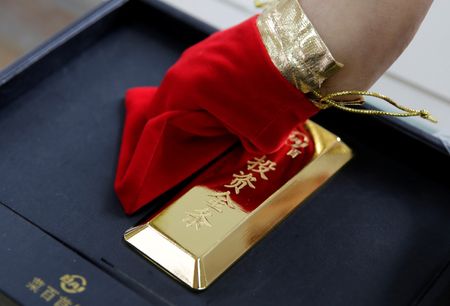By Polina Devitt and Kevin Yao
LONDON/BEIJING (Reuters) -Aggressive gold-buying by China’s central bank since 2023 has raised the question of how far Beijing will boost its reserves as it tries to reduce its reliance on the dollar and align its holdings with its status as the world’s second largest economy.
China’s purchases coincide with a rally from 2023 to 2025 that has driven gold prices to a record high of $3,508.5 per troy ounce on Tuesday.
The surge also highlights a broader trend of developing economies seeking to diversify from the dollar after Western sanctions froze $300 billion of Russia’s official reserves, about half of Moscow’s total, in 2022.
Russia’s central bank was left able only to access investments in yuan-denominated assets and gold stored domestically.
The People’s Bank of China has bought 21 metric tons of gold so far this year. Last year it bought 44 tons and in 2023 it purchased 225 tons, when it was the world’s largest buyer among central banks.
Future plans to buy gold for China’s state reserves, which officially stand at 2,300.4 tons, are a state secret. Reuters did not try to obtain any official targets for future gold-buying for this story, which relies on analysts’ estimates.
A target of 5,000 tons was suggested in 2009 by Hou Huimin, then the vice general secretary of the China Gold Association, citing the country’s rising international status and the 2008 global financial crisis.
If China targeted 5,000 tons in 2009, a higher number should probably be expected now as the country’s economy has since expanded rapidly, BNP Paribas analyst David Wilson said.
“We will continue seeing demand from the PBOC as China carries on with diversification and de-dollarisation of its reserves,” Wilson said.
Gold reserves at or above 5,000 tons would make China’s central bank the world’s second largest official holder of gold, behind the United States, which holds 8,133.5 tons, and ahead of France, Germany and Italy.
Central banks hold gold in their foreign currency reserves portfolio as a relatively low-risk asset, often seen as a hedge against inflation and geopolitical or economic uncertainty. In normal circumstances, they reduce purchases when gold prices are high.
“What is different now is that uncertainty itself has become systemic,” the United Nations agency for trade and development said in its Global Trade Update on Monday, adding that this hit developing economies hardest.
This year’s uncertainties have included U.S. President Donald Trump’s upending of Western security policy, his trade wars with China and other countries and his criticism of Fed chair Jerome Powell that have raised doubts about the independence of the U.S. Federal Reserve. None of these risks has been resolved.
A Chinese policy specialist involved in internal discussions, who declined to be named due to the sensitivity of the matter, told Reuters that China’s gold reserves were far from the level that would reflect its status of the world’s second largest economy.
“U.S. gold reserves are over 8,000 tons, our gold reserves should be at least 5,000 tons,” he said.
China’s economy, as measured by nominal gross domestic product, amounts to 64% of U.S. GDP. Applying this percentage to U.S. gold reserves of 8,133.5 would mean China’s gold reserves should be 5,205 tons.
That is more than double China’s holdings. According to official data, the PBOC held 2,300.4 tons of gold, valued at $244 billion, in its reserves in July. Western analysts say other state and state-controlled entities probably store further amounts in vaults in China.
The central banks of China and Poland were the most active buyers of gold among those reporting their purchases since 2023, and Poland has already achieved the targets it set for itself.
The National Bank of Poland, which holds 515 tons of gold in its reserves, said in 2024 that its gold-purchasing programme aimed to bolster its reserves given the risk that the frontline of the Russia-Ukraine conflict could come closer to its borders, destabilising the economy.
Poland’s gold purchases totalled 287 tons in 2023, 2024 and so far in 2025 combined, and led the share of gold to hit the central bank’s target – 20% of reserves – in April.
Meanwhile, U.S. gold reserves, which have been broadly unchanged in the last 25 years, make up 78% of its foreign currency reserves. This number is normal for advanced economies, which for historical reasons often have smaller currency reserves and more gold than developing countries.
China’s economic growth over the coming years will likely determine how much the central bank holds in its reserves, analysts say.
If China becomes the world’s largest economy in the next few decades, its gold reserves should exceed 8,000 tons, said independent consultant Robin Bhar.
China’s official gold holdings stand at 7% as a percentage of its total reserves, which is how many countries measure gold holdings. That means they are also low when compared to the global average of 22%.
This is partly because China’s total reserves of $3.6 trillion, including its gold, are vast, making it difficult to raise the percentage.
However, China’s role as the leading gold producer – at 8% of 4,974.5 tons of the 2024 total supply – will help, according to industry sources, as will holdings by other Chinese entities not yet declared.
“My sense is there is a desire to buy gold but without chasing the market higher,” said independent analyst Ross Norman. “China’s gold reserves are for sure a riddle wrapped inside a mystery.”
(Reporting by Polina Devitt and Kevin Yao;Editing by Pratima Desai and Barbara Lewis)











